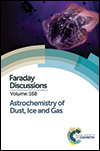The cycling of carbon into and out of dust
Abstract
Observational evidence seems to indicate that the depletion of interstellar carbon into dust shows rather wide variations and that carbon undergoes rather rapid recycling in the interstellar medium (ISM). Small hydrocarbon grains are processed in photo-dissociation regions by UV photons, by ion and electron collisions in interstellar shock waves and by cosmic rays. A significant fraction of hydrocarbon dust must therefore be re-formed by accretion in the dense, molecular ISM. A new dust model (Jones et al., Astron. Astrophys., 2013, 558, A62) shows that variations in the dust observables in the diffuse interstellar medium (nH ≤ 103 cm−3), can be explained by systematic and environmentally-driven changes in the small hydrocarbon grain population. Here we explore the consequences of gas-phase carbon accretion onto the surfaces of grains in the transition regions between the diffuse ISM and molecular clouds (e.g., Jones, Astron. Astrophys., 2013, 555, A39). We find that significant carbonaceous dust re-processing and/or mantle accretion can occur in the outer regions of molecular clouds and that this dust will have significantly different optical properties from the dust in the adjacent diffuse ISM. We conclude that the (re-)processing and cycling of carbon into and out of dust is perhaps the key to advancing our understanding of dust evolution in the ISM.
- This article is part of the themed collection: Astrochemistry of Dust, Ice and Gas

 Please wait while we load your content...
Please wait while we load your content...